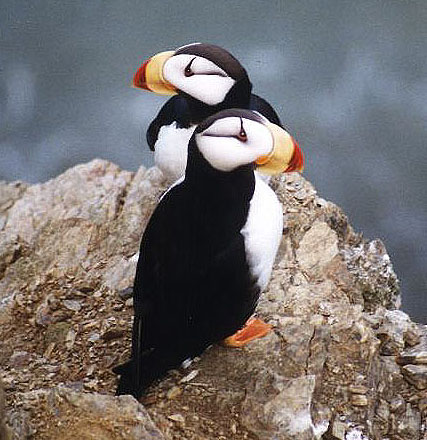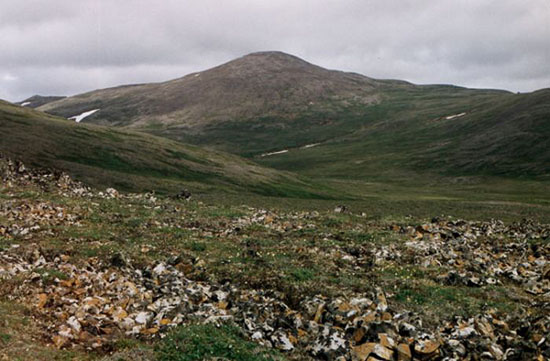Birds of Cape Peirce

At Cape Peirce there are a number of different habitats including sea cliffs and tundra. Many birds nest on the cliffs including Horned Puffins, Black-legged Kittiwakes, Common Mures, Pelagic Cormorants and Crested Auklets.On the tops of the cliffs birds such as Grey-crowned Rosy-finches, Water Pipits and Snow Buntings breed.

In the near distance behind me is Kittiwake Arch. On the cliffs behind and below me Pelagic Cormorants, Black-legged Kittiwakes and Common Mures breed. They make their nests on the tiny ledges with sedge and grasses found in marshy areas like the cabin ponds. The Common Ravens found here (the only bird to stay in the area all year) are masterful predators and spend most of their day hawking the cliffs and taking advantage of any opportunity to steal eggs. On occasion they will also kill Kittiwakes if they catch them on the ground. If a raven manages to steal an egg from a mure or kittiwake (an event occuring many times during the day) it usually hides it in the tundra and eats it at a later date (this is their lader for winter). I saw them on occasion flying in as far as the foothills of Slug Mountain to hide the eggs.
The small, white shelter on the hill is used to count and observe the walrus which haul-out on the beach below. In the bay, during spring and early summer, Grey Whales can also be spotted on their annual migration.
In the far distance is Cape Newenham.

This is Slug Mountain - the mountain seen in the distance in the photo on the previous page. On this mountain a host of birds breed including Rock Sandpipers (which are well camouflaged) and Snow Buntings (which do wonderful parachute courting displays). Further down from the mountain birds such as Lapland Longspurs (very confiding) and Savanna Sparrows breed on the tundra. In the valleys where stunted willow and alder brush is found birds such as both species of redpoll, some warblers (orange-crowned, yellow and Wilson's) and sparrows (fox, white-crowned and golden-crowned) breed. In the wetter, more marshy areas, birds such as Common Snipe (Gallinago gallinago delicatus)and Yellow Wagtail breed.
This is also good habitat to find a Brown Bear taking a midday nap!

I climbed the mountain once on an extraordinary clear and calm day. The top of the mountain was mostly rocky and almost bare of any vegetation (save for some lichen in protected spots). The view from the top, however, was a magnificent grand vista of the surrounding area. To the south of the mountain I could see Puffin Creek, Sanger Lake, Cape Peirce and Cape Newenham. Chagvan Mountain could be seen in the northwest and Hagermiester Island to the east. The only birds that I saw up there was a Lapland Longspur which payed me a quick visit (it seemed curious to see any creature up there at all). After taking some photos, eating some lunch, and placing a few rocks on the two cairns that others had built, I then made my way back to the cabins via the upper reaches of Puffin Creek and Sanger Lake.
This page hosted by